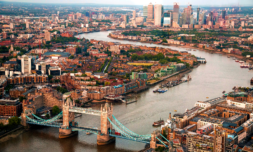What’s really inside the Thames’ water?
Announcing his plans, Sadiq Khan called the River Thames a ‘national embarrassment,’ with its waters being deemed notoriously unsafe and heavily polluted for several decades.
Search and rescue missions regularly take place beneath the waters, with divers calling their ventures ‘traumatising.’ In 2021, for example, 23 bodies were found in the Thames. Though this sounds like a lot, that figure has been steadily declining. In 2019, the Metropolitan Police found 27, in 2019 they found 30, and in 2015 they found 38.
With this knowledge, it should be unsurprising that there is also a ton of harmful bacteria currently lurking in the rivers’ waters.
A charity called River Action tested water from the Thames ahead of the Oxford and Cambridge Boat Race last month. It found E.coli levels 10 times above what the Environment Agency considers safe limit for swimming.
The charity points fingers at Thames Water, the company responsible for distributing water and treating wastewater in the area. There has been a 5 fold increase in sewage spills during the last year, putting the company at the forefront of a national scandal and intense scrutiny – all while managing its £15 billion debt problem.
There are also some cool things in the Thames, though, including relics from bygone ages such as Roman hair pins, Celtic helmets, statues, and jewellery. Locals can be spotted at low tide, ‘mudlarking’ in search of historical items and discarded valuables.
As for what else is in the Thames, well, that’ll be discovered when the cleanup project takes off.
Of course, the Mayor assures us that this all won’t happen ‘overnight,’ requiring a few years to complete. The CEO of River Action agrees, calling the scale of the challenge ‘absolutely massive’.

How the cleanup will happen
One major player in cleaning up the Thames has been under construction for years.
It has cost upward of £5 billion to construct, is 25 kilometres long, and connects 34 storm drains and sewers to a treatment centre in east London. It is none other than the Tideway Tunnel.
Expected to begin operating this summer, it will reduce the amount of raw sewage dumped into the Thames, however, questions about its efficacy in the face of intense rainfall caused by climate change have already been raised.
Officials also note that all of this will be fruitless if Thames Water doesn’t solve its leaky infrastructure, which leaks ‘thousands of hours of sewage’ into London’s waterways. Some are even hoping that the company goes bust in the coming weeks, claiming a new takeover could be beneficial to the rivers’ rehabilitation.
In the end, cleaning up the Thames will be no small feat. It’ll be interesting to see if the job is well done enough to encourage Londoners 10 years from now to take the plunge…





















